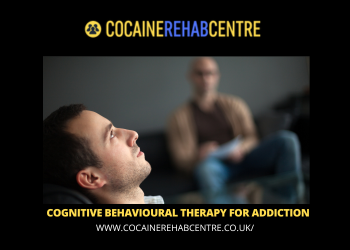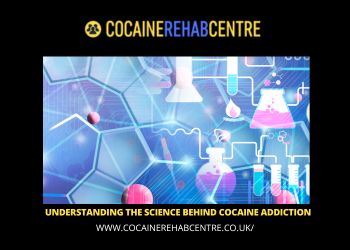20+ Years Experience
Specialist Cocaine Rehab

Enquire Today For A Free No Obligation Quote
Cocaine addiction is a complex and multifaceted issue that affects millions of individuals worldwide.
Beyond the well-known physical and social consequences, the neurological and behavioural aspects of cocaine hydrochloride addiction are often overlooked, yet they play a crucial role in understanding the nature of drug addiction and how to treat it.
This blog post will delve into the science behind cocaine addiction and unveil the neurological impact of this potent drug whilst exploring the intricate relationship between brain structure, function, and behaviour.
By the end of this post, you will have a deeper understanding of the underlying risk factors and mechanisms that drive drug-taking addiction as well as drug use and the potential avenues for effective treatment strategies.
Cocaine addiction is a neurological disorder characterised by an imbalance between dopamine and serotonin, which are essential neurotransmitters that regulate various brain functions.
These imbalances result from the effects of cocaine hydrochloride on the brain, causing an accumulation of dopamine and overactivation of receiving brain cells.
Drug taking ultimately leads to a pathological state of addiction, driving individuals to seek out and get cocaine effects and use the drug compulsively despite the negative consequences.
Repeated cocaine use can lead to mental health issues such as depression, anxiety, paranoia, panic attacks, and cocaine psychosis which can also cause delusions, hallucinations and aggressive behaviour.
Understanding the role of dopamine receptors and serotonin in cocaine addiction is essential for developing effective treatment strategies.
In the following sections, we will explore how these neurotransmitters contribute to the addictive process and the ways in which chronic cocaine use can have long-lasting adverse effects on brain structure and function.

The powerful feelings of pleasure and satisfaction associated with cocaine use can be attributed to the buildup of dopamine in the limbic system, particularly in the nucleus accumbens (NAc). This brain region is responsible for the pleasurable and rewarding effects experienced by cocaine abusers.
The overstimulation of dopamine receptors leads to long-term changes in the brain, contributing to the persistence of addiction and the increased likelihood of relapse.
In addition to its role in the reward system, dopamine also affects executive functions such as judgment, decision-making verbal memory, and mental flexibility, which are often impaired in chronic cocaine abusers.
This further illustrates the multifaceted impact of dopamine on the addicted brain, highlighting the need for targeted treatments that address both the reward and cognitive aspects of cocaine addiction.
While the role of dopamine in cocaine addiction is well-established, the involvement of serotonin is less understood. Research suggests that serotonin may play a crucial role in regulating dopamine levels, keeping the reward system in check.
In an animal study, it was found that 60% of animals exhibited addiction when cocaine was no longer associated with the serotonin transporter, indicating a potential link between serotonin and the addicted human brain.
This highlights the need for further research to elucidate the complex interplay between the dopamine transporter and serotonin in cocaine addiction and to develop treatment strategies that target both neurotransmitter systems.
Chronic cocaine use can have profound effects on brain structure and function, leading to long-term changes in the central nervous system that persist even after drug use has ceased.
Whether it is cocaine hydrochloride or crack cocaine, cocaine users are more likely to affect the structure of their brain which can lead to life-threatening consequences.
One of the most significant consequences is the reduction in grey matter volume and accelerated brain ageing, which can be considered a form of brain atrophy.
These structural changes can lead to cognitive and behavioural deficits, further complicating the process of recovery and increasing the risk of relapse.
In addition to grey matter atrophy, chronic cocaine use has also been associated with alterations in brain activation patterns and blood flow, particularly in the prefrontal and limbic regions.
These changes can contribute to the neuropsychiatric effects of chronic cocaine abuse, which include depression, anxiety, psychosis, cognitive impairments, brain disorders and cocaine-related deaths.
In the following sections, we will delve deeper into the specific structural and functional changes associated with chronic cocaine use and their implications for treatment.
Grey matter atrophy is a concerning consequence of cocaine use disorder, with imaging studies showing that a chronic cocaine abuser exhibits reduced grey matter volume in several brain regions, including the temporal lobe, frontal lobe, insula, and superior temporal gyrus.
These structural changes can have a detrimental effect on emotional recognition and language processing, further complicating the process of recovery from chronic abuse and increasing the risk of relapse for the cocaine user.
It is important to note that these structural changes are not limited to the brain regions mentioned above. Research has also shown that cocaine use does not result in substantial grey matter enlargement in the basal ganglia region.
This highlights the complex and multifaceted impact of prolonged exposure to cocaine on brain structure and emphasises the need for comprehensive approaches that address the diverse neurological consequences of chronic cocaine abuse.
Chronic cocaine and crack cocaine use is often associated with subtle cognitive difficulties, particularly those related to the prefrontal lobe.
Chronic cocaine abusers commonly report difficulties with executive functioning tasks, such as decision-making, judgment, attention, planning, and mental flexibility.
These issues can significantly impair daily activities and productivity. These cognitive impairments can have a significant impact on an individual’s ability to function in daily life and may contribute to the persistence of addiction.
Moreover, research suggests that heavy use of cocaine may be at least partly responsible for the observed correlation between the intensity of cocaine use and a decreased level of frontal lobe metabolism.
This further highlights the need for targeted interventions that address the cognitive and behavioural consequences of chronic cocaine use, as well as the underlying structural and functional changes in the brain.
Cocaine affects brain cells’ structure and function but also induces changes in gene expression and nerve cell structure.
One of the most significant findings in this area is the increased expression of the protein FosB in brain structures of the limbic system, leading to long-term changes in gene expression.
These alterations can have lasting effects on the brain, contributing to the persistence of addiction and the development of intense cravings for the drug.
Additionally, chronic cocaine exposure has been shown to cause nerve cells in the nucleus accumbens (NAc) to extend and form new offshoots on their dendrites.
This increased influence over the NAc can intensify cravings for cocaine, making it more difficult for individuals to resist the urge to use the drug.
In the following sections, we will discuss the role of FosB in cocaine addiction and explore the structural changes in nerve cells that contribute to the addictive process.
FosB is a genetic transcription factor that accumulates in the brain’s NAc cells due to chronic cocaine exposure. Its long-lasting effects may constitute an important molecular “switch” in the transition from drug abuse to addiction.
By influencing the expression of several genes involved in the reward pathway, FosB can contribute to the development and persistence of addiction.
Understanding the role of this transcription factor in cocaine addiction provides valuable insights into the molecular mechanisms underlying addiction and offers potential targets for novel therapeutic interventions.

The structural changes in nerve cells caused by chronic cocaine exposure have significant implications for the addictive process.
As nerve cells in the NAc extend and form new dendritic offshoots, their influence over the NAc increases, leading to intensified cravings for the drug.
These structural changes can persist even after drug use has ceased, making it more difficult for individuals to resist the urge to use cocaine and increasing the risk of relapse.
Addressing these structural changes, along with the alterations in gene expression, is crucial for developing effective treatment strategies that target the root causes of addiction.
In addition to the neurological and behavioural aspects of cocaine addiction, chronic cocaine abuse can also have significant neuropsychiatric effects.
Cocaine addiction symptoms can include depression, anxiety, psychosis, agitation, paranoia, hallucinations, delusions, violence, suicidal and homicidal thinking, poor insight and judgment, lack of foresight, and disinhibition.
Cocaine dependence can further exacerbate these symptoms, making it crucial to address neurological disorders of both addiction and dependence in treatment.
Moreover, drug use can lead to deficits in neurocognition, brain perfusion, and brain activation patterns, further complicating the process of recovery and increasing the risk of relapse.
Understanding the neuropsychiatric effects of chronic cocaine abuse is essential for future research and for developing comprehensive treatment strategies that address the diverse consequences of this powerful drug.
In the following sections, we will explore the cerebrovascular consequences of drug use and highlight the importance of neurobehavioral tests in detecting subtle behavioural effects.
Cocaine use can have serious cerebrovascular consequences, including ischemic and hemorrhagic strokes due to vasoconstriction and hypertension. The risk of hemorrhagic stroke is heightened with intravenous administration of the drug, as it can directly impact blood pressure in large and medium-sized brain vessels.
Additionally, repeated use of cocaine can lead to reduced cerebral glucose utilization in most brain regions, which may contribute to the neuropsychiatric effects of the drug.
Understanding these cerebrovascular consequences is crucial for developing effective treatment strategies and minimising the risk of long-term damage to the brain.
To detect the subtle behavioural effects of chronic cocaine abuse, neurobehavioral tests are necessary.
These tests can help identify cognitive impairments commonly observed in chronic cocaine users, such as deficits in executive function, decision-making, impulsivity, visuoperception, psychomotor speed, manual dexterity, verbal learning, and memory functions.
By assessing neurobehavioral functioning, clinicians can better understand the impact of cocaine use on an individual’s cognitive and emotional well-being and tailor treatment strategies accordingly.
Given the complex nature of cocaine addiction and its myriad neurological, behavioural, and neuropsychiatric consequences, it is vital to develop comprehensive treatment strategies that address all aspects of the disorder.
Targeting dopamine and serotonin systems, as well as addressing structural changes and gene expression, can help improve cocaine treatment outcomes and reduce the risk of relapse.
In addition to pharmacological interventions, behavioural therapies, and detox, novel approaches such as vaccines and neuromodulation techniques are being explored as potential treatment options for cocaine addiction.
As our understanding of the underlying mechanisms of addiction continues to evolve, it is crucial to remain open to new treatment modalities and to continually refine and adapt our approach to the ever-changing landscape of addiction treatment.
Targeting the dopamine and serotonin systems in the brain is a promising avenue for treating cocaine addiction, given their critical roles in reward and mood regulation.
By modulating these neurotransmitters, it may be possible to reduce the compulsive urge to use cocaine and alleviate some of the negative consequences associated with chronic use.
Developing pharmacological interventions that effectively target these systems could represent a major advance in the treatment of cocaine addiction and improve the lives of countless drug abusers struggling with this debilitating disorder, as well as address the challenges posed by other drugs.

In addition to targeting neurotransmitter systems, addressing the structural changes and alterations in gene expression induced by drug use is essential for comprehensive treatment strategies.
By targeting the root causes of addiction, such as the activation of FosB and the formation of dendritic spines, it may be possible to reduce the intensity of cravings and prevent relapse.
Further research is needed to better understand the complex interplay between structural changes, gene expression, and neurotransmitter systems, and to develop innovative treatment approaches that effectively address these underlying mechanisms.
If you or a loved one is struggling with an addiction to cocaine or other drugs, seeking professional help is crucial.
At our rehab clinic, we offer a range of evidence-based treatments and therapies tailored to the unique needs of each individual.
Our compassionate and experienced team is dedicated to providing the support and guidance necessary for a successful recovery.
Don’t let drug addiction control your life any longer – contact our clinic today and take the first step towards a happier, healthier future.
In conclusion, cocaine addiction is a complex and multifaceted issue that extends beyond the physical and social consequences typically associated with drug use.
By examining the neurological, behavioural, and neuropsychiatric effects of cocaine, we can gain a deeper understanding of the underlying mechanisms driving compulsive drug-seeking and develop more effective treatment strategies.
Targeting dopamine and serotonin systems, addressing structural changes and gene expression, and exploring novel therapeutic approaches are all crucial components of a comprehensive approach to treating cocaine addiction.
It is our hope that this blog post has provided you with valuable insights into the science behind cocaine addiction, the neurological impact of this potent drug, and the potential avenues for effective treatment.
As we continue to learn more about the complex interplay between brain structure, function, and behaviour in addiction, we must remain committed to advancing our understanding and refining our treatment strategies to better serve those struggling with this debilitating disorder.
Dopamine is a key factor in cocaine addiction, as it is released by the drug to produce feelings of pleasure and reward.
This leads to the cycle of seeking the drug as an inescapable habit, resulting in compulsive use and, ultimately, addiction.
Chronic cocaine use has a profound impact on the brain, leading to reduced grey matter and brain volume, accelerated brain ageing, and cognitive and behavioural issues.
Long-term use of the substance is linked to significant impairments in the way our brains operate.
FosB plays an important role in cocaine addiction, as it accumulates in the brain’s NAc cells following repeated drug exposure, where it acts as a molecular switch that can lead to drug cravings and long-term addiction.
This accumulation of FosB in the NAc cells is thought to be a key factor in the development of addiction, as it can lead to changes in gene expression and other molecular processes that can lead to compulsive drug use and long-term addiction.

Repeated substance abuse especially if drug users inject cocaine can significantly decrease the blood supply to the brain, causing ischemic and hemorrhagic strokes.
This risk is further increased with intravenous administration of the drug.
For those struggling with cocaine addiction, some of the most effective treatment approaches may be behavioural therapies such as cognitive behavioural therapy and contingency management, along with medications to address cravings.
These therapies can help individuals identify cocaine triggers and develop strategies to cope with them. They can also help individuals develop healthier coping skills and lifestyle changes to reduce the risk of relapse.
Medications can help reduce cravings and withdrawal symptoms, making it easier to use them.
Do you want to learn more about the effects of cocaine addiction? Have a look at the list below for more information:

























We Aim To Reply To All Enquiries With-in 24-Hours